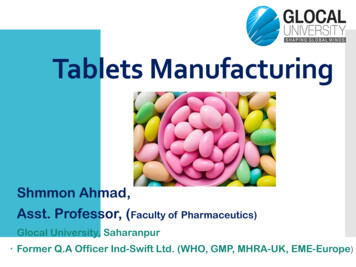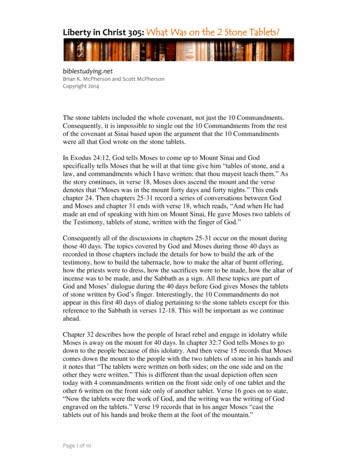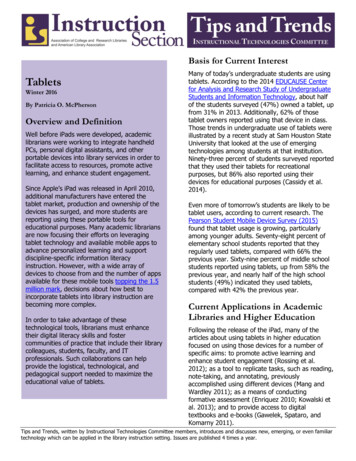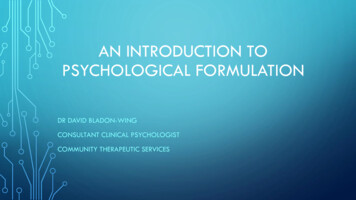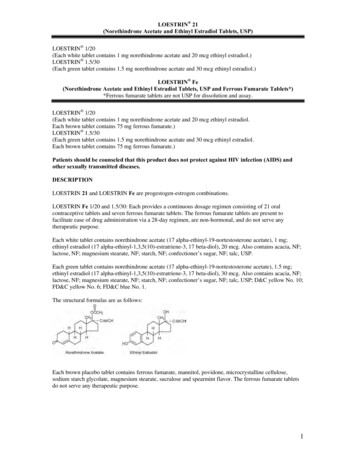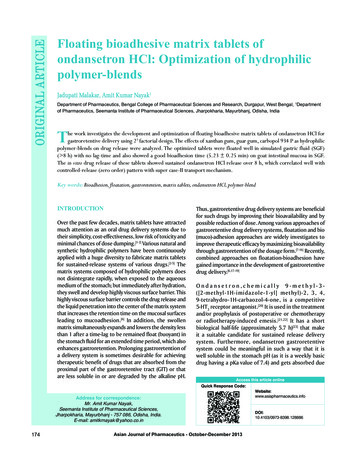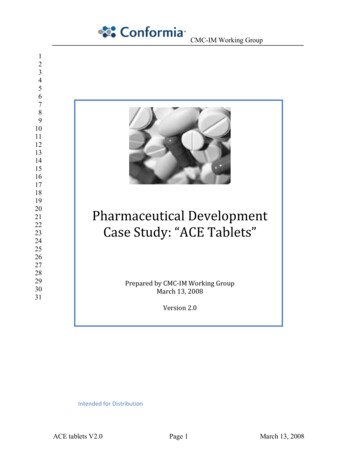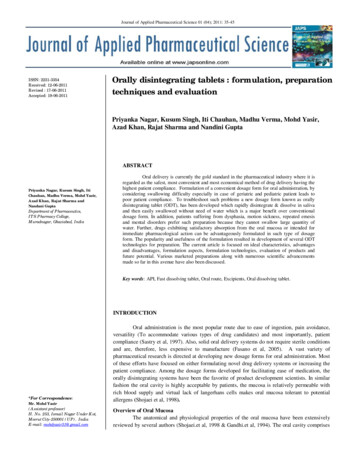
Transcription
Journal of Applied Pharmaceutical Science 01 (04); 2011: 35-45ISSN: 2231-3354Received: 12-06-2011Revised : 17-06-2011Accepted: 19-06-2011Orally disintegrating tablets : formulation, preparationtechniques and evaluationPriyanka Nagar, Kusum Singh, Iti Chauhan, Madhu Verma, Mohd Yasir,Azad Khan, Rajat Sharma and Nandini GuptaABSTRACTPriyanka Nagar, Kusum Singh, ItiChauhan, Madhu Verma, Mohd Yasir,Azad Khan, Rajat Sharma andNandani GuptaDepartment of Pharmaceutics,ITS Pharmacy College,Muradnagar, Ghaziabad, IndiaOral delivery is currently the gold standard in the pharmaceutical industry where it isregarded as the safest, most convenient and most economical method of drug delivery having thehighest patient compliance. Formulation of a convenient dosage form for oral administration, byconsidering swallowing difficulty especially in case of geriatric and pediatric patient leads topoor patient compliance. To troubleshoot such problems a new dosage form known as orallydisintegrating tablet (ODT), has been developed which rapidly disintegrate & dissolve in salivaand then easily swallowed without need of water which is a major benefit over conventionaldosage form. In addition, patients suffering from dysphasia, motion sickness, repeated emesisand mental disorders prefer such preparation because they cannot swallow large quantity ofwater. Further, drugs exhibiting satisfactory absorption from the oral mucosa or intended forimmediate pharmacological action can be advantageously formulated in such type of dosageform. The popularity and usefulness of the formulation resulted in development of several ODTtechnologies for preparation. The current article is focused on ideal characteristics, advantagesand disadvantages, formulation aspects, formulation technologies, evaluation of products andfuture potential. Various marketed preparations along with numerous scientific advancementsmade so far in this avenue have also been discussed.Key words: API, Fast dissolving tablet, Oral route, Excipients, Oral dissolving tablet.INTRODUCTION*For Correspondence:Mr. Mohd Yasir(Assistant professor)H. No. 253, Ismail Nagar Under Kot,Meerut City-250001 (UP). IndiaE-mail: mohdyasir31@gmail.comOral administration is the most popular route due to ease of ingestion, pain avoidance,versatility (To accommodate various types of drug candidates) and most importantly, patientcompliance (Sastry et al, 1997). Also, solid oral delivery systems do not require sterile conditionsand are, therefore, less expensive to manufacture (Fasano et al, 2005). A vast variety ofpharmaceutical research is directed at developing new dosage forms for oral administration. Mostof these efforts have focused on either formulating novel drug delivery systems or increasing thepatient compliance. Among the dosage forms developed for facilitating ease of medication, theorally disintegrating systems have been the favorite of product development scientists. In similarfashion the oral cavity is highly acceptable by patients, the mucosa is relatively permeable withrich blood supply and virtual lack of langerhans cells makes oral mucosa tolerant to potentialallergens (Shojaei et al, 1998).Overview of Oral MucosaThe anatomical and physiological properties of the oral mucosa have been extensivelyreviewed by several authors (Shojaei.et al, 1998 & Gandhi.et al, 1994). The oral cavity comprises
Journal of Applied Pharmaceutical Science 01 (04); 2011: 35-45the lips, cheek, tongue, hard palate, soft palate and floor of themouth (Fig. 1). The lining of the oral cavity is referred to as theoral mucosa, and includes the buccal, sublingual, gingival, palataland labial mucosa. The buccal, sublingual and the mucosal tissuesat the ventral surface of the tongue account for about 60% of theoral mucosal surface area. The top quarter to one-third of the oralmucosa is made up of closely compacted epithelial cells (Fig. 2).The primary function of the oral epithelium is to protectthe underlying tissue against potential harmful agents in the oralenvironment and from fluid loss (Collins et al 1987). Beneath theepithelium are the basement membranes, lamina propia andsubmucosa. The oral mucosa also contains many sensory receptorsincluding the taste receptors of the tongue. Three types of oralmucosa can be found in the oral cavity; the lining mucosa is foundin the outer oral vestibule (the buccal mucosa) and the sublingualregion (floor of the mouth) (Fig. 1). The specialized mucosa isfound on the dorsal surface of tongue, while the masticatorymucosa is found on the hard palate (the upper surface of themouth) and the gingival (gums) (Smart et al, 2004).The lining mucosa comprises approximately 60%, themasticatory mucosa approximately 25%, and the specializedmucosa approximately 15% of the total surface area of the oralmucosal lining in an adult human. The masticatory mucosa islocated in the regions particularly susceptible to the stress andstrains resulting from masticatory activity. The superficial cells ofthe masticatory mucosa are keratinized, and a thick lamina propiatightly binds the mucosa to the underlying periosteum. Liningmucosa on the other hand is not nearly as subject to masticatoryloads and consequently, has a non-keratinized epithelium, whichsits on a thin and elastic lamina propia and a sub mucosa. Themucosa of the dorsum of the tongue is a specialized gustatorymucosa, which has well papillated surfaces which are bothkeratinized and some non-keratinized (Collins et al, 1987). Table 1depicted the advantages and disadvantages associated withutilizing the oral mucosa as a drug delivery site.Fig. 1: Schematic representation of the different linings of mucosa in mouth(Squier.et al, 2001)decade, particularly for geriatric and pediatric patients whoexperience difficulty in swallowing conventional tablets andcapsules. Hence, they do not comply with prescription, whichresults in high incidence of ineffective therapy (Seager et al, 1998)Fig.2: Schematic diagram of buccal mucosa (Smart et al, 2004)Table1: The advantages and disadvantages associated with utilizing the oralmucosa as a drug delivery site (Sankar et al, f administrableOral mucosa repairs rapidlyDifferent areas of the oralcavityhavedifferentpermeability characteristicsHighly hydrated environmentto dissolve drugSustained delivery possiblePotential reduction of systemicside effectsAvoid the hepatic first-passeffectHigh blood supplyFast systemic delivery possibleDisadvantages1.2.3.4.5.6.7.8.Permeability barrier of the oralmucosaSaliva washes away drugMastication and speech maydislodgeDelivery deviceRequiresformulationforagreeabletasteHighly enzymatic environmentRelatively small surface areaRisk of choking on orswallowing delivery deviceIn disease conditions such as motion sickness, suddenepisodes of attacks of coughing and repeated emesis swallowingconventional solid dosage forms become difficult. Orallydisintegrating dosage forms can serve as an effective alternativemode of drug delivery in such situations (Ghosh et al, 2005). Whenput in the mouth, these dosage forms disintegrate instantly torelease the drug, which dissolves or disperses in the saliva (Dobettiet al, 2001). Thereafter, the drug may get absorbed from thepharynx and esophagus or from other sections of GIT as the salivatravels down. In such cases, bioavailability is significantly greaterthan that observed from conventional tablet dosage form (Brown etal 2001 & Deepak et al, 2004).The novel technology of oral disintegrating dosage formsis known as fast dissolve, rapid dissolve, rapid melt and quickdispersible tablets (Gupta et al, 2010). However, the function andconcept of all these dosage forms are similar. Different orallydisintegrating dosage forms are as follows:ORALLY DISINTEGRATING DOSAGE FORMS1.The concept of orally disintegrating dosage forms hasemerged from the desire to provide patients with moreconventional means of taking their medication. Interestingly, thedemand for ODDFs has enormously increased during the last2.Orally disintegrating tablets: It is a tablet that dissolves ordisintegrates in the oral cavity without the need of water orchewing (Gupta et al, 2010).Fast dissolving films: The fear of taking solid tablets and therisk of choking for certain patient population still existsdespite their short dissolution and disintegration time. It
Journal of Applied Pharmaceutical Science 01 (04); 2011: 35-453.4.5.consists of very thin oral strip, which releases the activeingredient immediately after uptake in to the oral cavity. Itcombines all advantages of tablets along with liquid dosageforms. This system is simply placed on patients tongue or anyother mucosal surface, instantly wet by saliva; film rapidlyhydrates and dissolves to release the medication (Vollmer etal, 2007).Fast Caps: A new type of fast disintegrating drug deliverysystem based on gelatin capsules was developed. In contrast toconventional hard gelatin capsules, the fast caps consist ofgelation of low bloom strength and various additives toimprove the mechanical and dissolution properties of capsuleshell. It includes several advantages like high drug loading,possible solid and liquid filling, and no compression of coatedtaste masked or extended release drug particles / pellets, goodmechanical properties, simple manufacturing, mechanicalstability and requirement of special packaging. (Bodmeier etal, 1999).Medicated chewing gums: it is an attractive alternative fordrug delivery system with several advantages includingconvenience for administration, mainly chewing gum is usedto promising controlled release drug delivery system. Theseare mainly available currently for pain relief, smokingcessation, travel illness and freshening of breath.(Pandit et al,2006).Freeze-dried wafer: it is a quick-disintegrating, thin matrix thatcontains a medicinal agent that does not need water forswallowing. This fragile dosage form requires unit-dosepackaging to ensure physical stability. The wafer disintegratesinstantaneously in the oral cavity and releases drug, whichdissolves or disperses in the saliva. The saliva is swallowedand the drug is absorbed across the gastrointestinal tract (GIT).(Dobetti et al, 2001).3.4.5.6.7.8.Advantages of ODTs1.2.3.4.5.6.7.ORALLY DISINTEGRATING TABLETSThe performance of ODTs depends on the technologyused in their manufacture. The orally disintegrating property ofthese tablets is attributable to the quick ingress of water into thetablet matrix, which creates porous structure and results in rapiddisintegration. Hence, the basic approaches to develop ODTsinclude maximizing the porous structure of the tablet matrix,incorporating the appropriate disintegrating agent and using highlywater-soluble excipients in the formulation (Wilson et al, 1987).8.Ideal characteristics of ODTs13.ODTs should depict some ideal characteristics to distinguish themfrom traditional conventionaldosage forms. Important desirable characteristics of these dosageforms include (Kuchekar et al, 2003)1.2.No water requirement for swallowing purpose but it shoulddissolve or disintegrate in the mouth usually within fraction ofseconds.Provide pleasant feeling in the mouth.Be compatible with taste masking.Be portable without fragility concern.Leave negligible or no residue in the mouth after oraladministration.Exhibit low sensitivity to altered environmental conditionssuch as humidity and temperature.Allow high drug loading.Adaptable and amenable to conventional processing andpackaging equipment at nominal expense.9.10.11.12.14.15.16.17.18.ODT can be administer to the patients who cannot swallowtablets/cap., such as the elderly, stroke victims, bedriddenpatients, patients with esophageal problems & patients whorefuse to swallow such as pediatric, geriatric & psychiatricpatients and thus improves patient compliance (Wilson et al,1987).It contain the certain studies which concluded increasedbioavailability and proved rapidabsorption of drugsthrough pregastric absorption of drugs from mouth, pharynx& esophagus as saliva passes down (Fix et al, 1998).ODT is most convenient for disabled, bedridden patients,travelers and busy people, who do not always have access towater (Fix et al, 1998).Good mouth feel property of ODT helps to change theperception of medication (Allen et al, 1997).As bitter pill particularly in pediatric patients (Wilson et al,1987).The risk of chocking or suffocation during oral administrationof conventional formulations due to physical obstruction isavoided, thus providing improved safety (Indurwade et al,2000).ODT opened new business opportunity like productdifferentiation, product promotion, patent extension and lifecycle management (Wilson et al, 1987).Suitable during traveling where water may not be available(Fix et al, 1998).No specific packaging required can be packaged in pushthrough blisters (Kuchekar et al, 2003).Conventional manufacturing equipment (Kuchekar et al,2003).Cost effective (Wilson et al, 1987).Good chemical stability as conventional oral solid dosageform (Allen et al, 1997).New business opportunity like product differentiation, productpromotion, patent extension and life style management(Wilson et al, 1987).Allow high drug loading (Fix et al, 1998).Provides rapid drug delivery from dosage forms (Allen et al,1997).Provide advantage of liquid medication in form of solidpreparation (Shyamala et al, 2002)Rapid drug therapy intervention (Wilson et al, 1987)No chewing needed (Fix et al, 1998).
Journal of Applied Pharmaceutical Science 01 (04); 2011: 35-4519. Adaptable and amenable to existing processing and packagingmachinery(Wilson et al, 1987)20. Rapid onset of action (Bradoo et al, 2001)Disadvantages of ODTs1.2.3.4.ODT is hygroscopic in nature so must be keep in dry place(Devrajan et al, 2003)Some time it possesses mouth feeling (Chang et al, 2000).It is also shows the fragile, effervescence granules property(Chang .et al, 2000)ODT requires special packaging for properly stabilization &safety of stable product (Devrajan et al, 2003)include neuroleptics, cardiovascular agents, analgesics,antiallergic, anti-epileptics, anxiolytics, sedatives, hypnotics,diuretics, anti-parkinsonism agents, anti-bacterial agents and drugsused for erectile dysfunction (Kushekar et al, 2003)In contrast, the following characteristics may renderunsuitable for delivery as an orally disintegrating tablet:1. Short half life and frequent dosing.2. Very bitter or otherwise unacceptable taste because tastemasking cannot be successfully achieved.3. Require controlled or sustained release.4. Combination with anticholinergics.ODTs involve the following mechanisms to achieve thedesired fast dissolving characteristics (Sahoo et al, 2010):B. Selection of excipients: Mainly seen excipients in ODT are asfollows at least one disintegrant, a diluent, a lubricant, andoptionally, a swelling agent, sweeteners, and flavoring agents etc.Ideal bulk excipients for orally disintegrating dosage forms shouldhave the following properties (Bansal et al, 2003):1.1.MECHANISMS OF ODTs2.3.Water must quickly enter into the tablet matrix to cause rapiddisintegration and instantaneous dissolution of the tablet.Incorporation of an appropriate disintegrating agent or highlywater soluble excipients in the tablet formulation.There are some under mentioned mechanisms by which thetablet is broken down into the smaller particles and thensubsequently result a solution or suspension of the drug. Themechanisms are High swellability of disintegration Chemical reaction Capillary action2.3.Disperses and dissolves in the mouth within a few secondswithout leaving any residue.Masks the drug’s offensive taste and offers a pleasant mouthfeel.Enables sufficient drug loading and remains relativelyunaffected by changes in humidity or temperature.The role of excipients is important in the formulation offast-melting tablets. The temperature of the excipients should bepreferably around 30–350C for faster melting properties. Detail ofexcipients is given in table 2 & 3.Table 2: Excipients to be used for the preparation of ODTs (Liang .et al, 2001)FORMULATION ASPECTS OF ODTsImportant ingredients that are used in the formulation ofODTs should allow quick release of the drug, resulting in fasterdissolution. This includes both the pharmacologically activeingredients (drug) and the excipients (additives).A. Selection of drug candidate: Several factors may be consideredwhile selecting an appropriate drug candidate for development oforally disintegrating tablets. The ultimate characteristics of a drugfor dissolution in mouth and pregastric absorption from fastdissolving tablets include (Reddy et al, 2002)1.2.3.4.5.6.7.Free from bitter tasteDose lower than 20mgSmall to moderate molecular weightGood solubility in water and salivaPartially unionized at oral cavity pHAbility to diffuse and partition in to the epithelium of upperGIT(log 1,or preferably 2)Ability to permeate oral mucosal tissue.There are no particular limitations as long as it is asubstance which is used as a pharmaceutical active ingredient.Researchers have formulated ODT for various categories of drugsused for therapy in which rapid peak plasma concentration isrequired to achieve the desired pharmacological response. creases the rate ofdisintegration and hence thedissolution. The presence ofother formulation ingredientssuch as water-solubleexcipients and effervescentagents further hastens theprocess of disintegration. Forthe success of fast dissolvingtablet, the tablet havingquick dissolving propertywhich is achieved by usingthe super disintegrantFlavorsIncreases Patient complianceand acceptabilitySweeteners andsugar basedexcipientsThis is another approach tomanufacture ODT by directcompression. Sugar basedexcipients acts as bulkingagents .These exhibits highaqueoussolubilityandsweetness, and hence imparttaste masking property and apleasing mouth feel.Reduces interfacial tensionand thus enhancessolubilization of FDTCrospovidone,Microcrystalline cellulose,sodium starch glycolate,sodium carboxy methylcellulose, pregelatinzedstarch,Carboxy methyl cellulose,and modified corn starch.Sodium starch glycolate hasgood flowability thancrosscarmellose sodium.Cross povidone is fibrousnature and highlycompactablePeppermint flavor, coolingflavor, flavor oils andflavoring aromatic oil,peppermint oil, clove oil, bayoil, anise oil, eucalyptus oilthyme oil, oil of bitteralmonds. Flavoring agentsinclude, vanilla, citrus oils,fruit essences.Artificial sweeteners likeAspartame, Sugarsderivatives. Bulking agentslike dextrose, fructose,isomalt, lactilol, maltitol,maltose, mannitol, sorbitol,starch hydrolysate,polydextrose and xylitolSurface e,polyoxyethylene sorbitanfatty acid esters (Tweens),
Journal of Applied Pharmaceutical Science 01 (04); 2011: 35-45BinderColorLubricantsFillersMaintains integrity of dosageform prior to administrationEnhances appearance andorganoleptic properties ofdosage formLubricant helps reducefriction and wear byintroducing a lubricatingfilm between mechanicalmoving parts of tabletpunching machineEnhances bulk of dosageformsorbitan fatty acid esters(Spans), ,Polyvinylalcohl(PVA)Hydroxy propylmethylcellulose(HPMC)Sunset yellow, Amaranth,Red iron oxideStearic acid, Magnesiumstearates, Zinc state, calciumstate, talc, polyethyleneglycol, liquid paraffin,magnesium lauryl sulfate,colloidal silicon dioxide.Directly compressible spraydried Mannitol, Sorbitol,xylitol, calcium carbonate,magnesium carbonate,calcium phosphate, calciumsulfate,pregelatinzed starch,magnesium trisilicate,aluminium hydroxideTable 3: Superdisintegrants to be used for the preparation of ODTs (Bhowmik.et ce ZSXPrimellose SolutabVivasol L-HPCCrospovidoneCrospovidone MKollidonPolyplasdoneCross linkedcelluloseSodium starchglycolateExplotabPrimogelCross linkedstarchAlginic acid NFSatialgineCross linkedalginic acid-Rapid swelling inaqueous mediumor wicking actionSoypolysaccharidesEmcosoyNatural superdisintegrant-Does not containanystarch or sugar.Used innutritional productsCalcium silicate-WickingactionCross linkedPVPMechanism ofaction-Swells 4-8 folds in 10 seconds.-Swelling andwicking both.Swells very littleAnd returns tooriginal size aftercompression but actby capillary actionSwells 7-12 folds in 30 secondsSpecial comment-Swells in twodimensions.-Directcompression orgranulation-Starch free-Water insolubleandspongy in natureso getporous tablet-Swells in threedimensions andhigh level serve assustainrelease matrix-Promotedisintegrationin both dry or wetgranulationet al, 1993). Detail of all these conventional techniques is given intable 4.Patented TechniquesRapid-dissolving characteristic of ODTs is generallyattributed to fast penetration of water into tablet matrix resulting inits fast disintegration. Several technologies have been developedon the basis of formulation aspects and different processes andresulting dosage forms vary on several parameters like mechanicalstrength, porosity, dose, stability, taste, mouth feel, dissolution rateand overall bioavailability. Table 5 represents the list of uniquepatented technologies, their advantages, disadvantages, and Table6 represents the patented technology and their branded products.EVALUATION OF ODTsEvaluation parameters of tablets mentioned in thePharmacopoeias need to be assessed, along with some special tests.The quality of tablet, once formulated by rule, is generally dictatedby the quality of physicochemical properties of blends (Reddy etal, 2002). There are many formulation and process variablesinvolved in mixing and all these can affect the characteristics ofblends produced (Kushekar et al, 2003).A. Evaluation of blends before compression: The variouscharacteristics of blends to be tested before compression are(Kushekar et al, 2003 & Shyamala et al, 2002):1. Angle of repose: Angle of repose is determined by using funnelmethod. The accurately weighed blend is taken in a funnel. Theheight of the funnel is adjusted in such a way that the tip of thefunnel just touches the apex of the heap of blend. The drug (assolid dispersion)-excipient blend is allow to flow through thefunnel freely on to the surface. The diameter of the powder cone ismeasured and angle of repose is calculated using the followingequation.Tan Ө h/rHighly porous,Optimumconcentration isbetween 20-40%TECHNIQUES FOR PREPARATION OF ODTsThe techniques used to manufacture ODTs can beclassified as:1) Conventional techniques2) Patented techniquesConventional TechniquesThe various conventional technologies are developed forthe preparation of Orally Disintegrating drug delivery system thatare Freeze drying, Spray drying, Molding , Phase transitionprocess, Melt granulation, Sublimation, Mass Extrusion, CottonCandy Process, Direct compression (Meyers et al, 1995 & MakinoWhere h and r are the height of cone and radius cone baserespectively. Angle of Repose less than 30 shows the freeflowing of the material.Bulk density: Apparent bulk density is determined by pouring aweighed quantity of blend into graduated cylinder and measuringthe volume and weight. Bulk density can be calculated by usingfollowing formula:Bulk density Weight of the powder / Volume of the packing.Tapped density: It is determined by placing a graduated cylinder,containing a known mass of drug-excipients blend. The cylinder isallowed to fall under its own weight onto a hard surface from theheight of 10 cm at 2 second intervals. The tapping is continueduntil no further change in volume is noted. Tapped density can becalculated by using following formula:Tapped Density (Weight of the powder / volume of the tapped packing)
Journal of Applied Pharmaceutical Science 01 (04); 2011: 35-45Table 4: Conventional techniques used for the preparation of ODTs.S.NoTechniques1Disintegrantaddition2.Freeze DryingorLyophilizationMethod and characteristics of prepared ODTsInvolves the addition of superdisintegrants in optimum concentration to the formulation to achieve rapid disintegration/dissolution. For e.g.MCC and sodium starch glycolate are used in formulation of Efavirenz, Crystalline cellulose (AvicelPH-102)and low substituted HPEC usedin oxybutinin and pirenzepine formulation. Crospovidone used in galanthamine HBr. Crospovidone (3%w/w) and crosscarmellose Na(5%w/w) used in prochlorperazine maleate formulation.Characteristics: similar to conventional tablets with higher % of disintegrants, lower hardness and higher % of friabilityThe drug is dissolved or dispersed in an aqueous solution of a carrier. The mixture is poured into the wells of the preformed blister packs.The trays holding the blister packs are passed through liquid nitrogen freezing tunnel to freeze the drug solution. Then the frozen blisterpacks are placed in refrigerated cabinets to continue the freeze drying. Finally the blisters are packaged and shipped.Characteristics: The preparations are highly porous, have high specific surface area, dissolve rapidly and ultimately show improvedabsorption and bioavailability.Dose incorporated:- insoluble 400mgWater soluble drug loading:- 60mgAdvantages of Freeze drying Tablets produced by this technique possess very low disintegration time. Render tablets with great mouth feel due to fast melting effect. Provides immediate dissolution (5 sec). Increases absorption and bioavailability of drug. Lyophilization is useful for heat a sensitive drug that is thermo labile substances. Tablets prepared by lyophilization disintegration rapidly in less than 5 sec due to quick penetration of saliva in pores when placedin oral cavity.Disadvantages of freeze drying Relatively expensive and time consuming process. The product obtained is poorly stable and fragile, sensitive to humidity rendering conventional packaging unsuitable. Very poor physical resistance, High cost of production, Low dose of water-soluble drugsWater-soluble ingredients with a hydro alcoholic solvent is used and is molded into tablets under pressure lower than that used inconventional tablet compression.Characteristics: Molded tablets are very less compact than compressed tablet porous structure that enhances disintegration/dissolution andfinally absorption increased.Advantages : Very rapid dissolution (5–15 s)Disadvantages : High cost of production , Weak mechanical strength Possible limitations in stabilityInert solid ingredients that volatilize rapidly like urea, camphor ammonium carbonate, ammonium bicarbonate, and hexamethylenetetraminewere added to the other tablet ingredients and the mixture is compressed into tablets. The volatile materials were then removed viasublimation, which generates porous structure.Characteristics: Porous structure that enhances dissolution by using volatile material or solvent e.g. cyclohexane, benzene etc.Advantages: Good physical resistance & highly porous structureDisadvantages: Harmful residual adjuvant, Extra equipments for heating, Not applicable to volatile and heat sensitive drugsBy hydrolyzed and non hydrolyzed gelatins as supporting agents, mannitol as bulking agent, sodium starch glycolate orcrosscarmellose sodium as disintegrating agent and an acidic material (e.g. citric acid) and / or alkali material (e.g. Sodium bicarbonate) toenhance disintegration /dissolution.(Mishra DN.et al)Characteristics: Prepared tablet disintegrates within 20 seconds when immersed in an aqueous sionInvolves softening the active blend using the solvent mixture of water soluble polyethylene glycol, methanol and expulsion of softened massthrough the extruder or syringe to get a cylindrical shape of the product into even segments using heated blade to form tablets.Characteristics: The dried product can be used to coat granules of bitter tasting drugs and thereby masking their bitter taste.7Directcompression8Cotton candyprocessConventional equipment, commonly available excipients and a limited number of processing steps are involved in direct compression.Characteristics: It is most cost effective tablet manufacturing technique.Advantages Requires fewer unit operations compared with wet Granulation (shorter processing time and lower energy consumption) Fewer stability issues for actives that are sensitive to heat or moisture For certain compounds, faster dissolution rates may be generated from tablets prepared by direct compression compared with wetgranulation; for example, Norfloxacin. Fewer excipients may be needed in a direct compression Formula.Disadvantages Issues with segregation – these can be reduced by matching The particle size and density of the active drug substance with excipients In general, the drug content is limited to approximately 30% or approximately 50 mg Not suited for poorly flowing drug compounds Static charges may develop on the drug particles or excipients during mixing, which may lead to agglomeration of particles producingpoor mixingInvolves the formation of matrix of polysaccharides by simultaneous action of flash melting and spinning. This candy floss matrix is thenmilled and blended with active ingredients and excipients afterre-crystallization and subsequently compressed to FDT.Characteristics: It can accommodate high doses of drug and offers improved mechanical strength.9Compactiona) Meltgranulationb) PhasetransitionprocessPrepared by incorporating a hydrophilic waxy binder (super polystate) PEG-6-stearate. Super polystate not only acts as binder and increasephysical resistance of tablet but also helps the disintegration of tablet.Characteristics: It melts in the mouth and solubilizes rapidly leaving no residue.Prepared by compressing a powder containing two sugar alcohols with high and low melting points and subsequent heating at a temperaturebetween their melting points. T
Orally disintegrating tablets: It is a tablet that dissolves or disintegrates in the oral cavity without the need of water or chewing (Gupta et al, 2010). 2. Fast dissolving films: The fear of taking solid tablets and the risk of choking for certain patient population still exists despite their short dissolution and disintegration time. .



